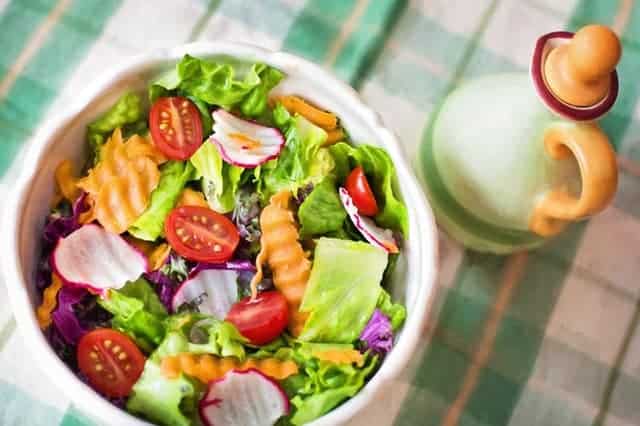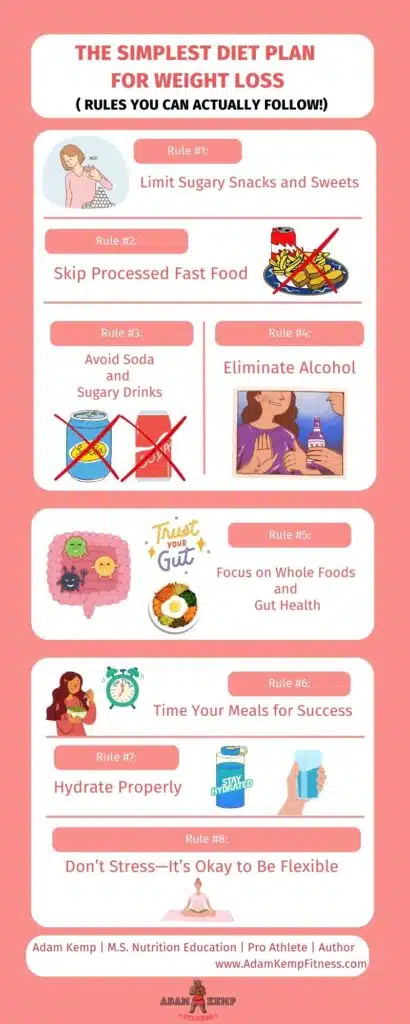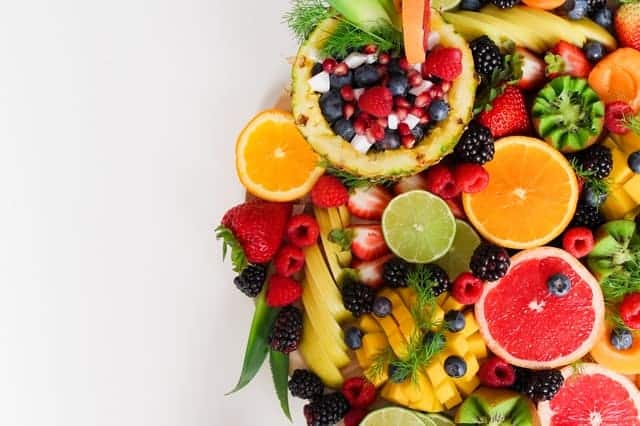How to Lose 20 Pounds in 2 Weeks
Want to lose 20 pounds in 2 weeks? Well, losing 20 pounds in 2 weeks is nearly impossible.
However, you can drop 20 pounds fast without compromising your health by using risky diet fads or weight loss supplements by using the tips in this article!
Perhaps you’re trying to stick to your New Year’s resolution, or maybe you have an event like a wedding coming up soon, so you want to lose 20 pounds fast.
Or do you simply want to be a healthier version of yourself and get an aesthetic body?
As a professional athlete and nutrition educator, I understand the appeal of fast results, but I also know the importance of sustainable changes to make those results last.
This guide outlines effective strategies for creating a calorie deficit, maintaining muscle, and enhancing your metabolism, all while being mindful of safety and well-being.
Instead of trying to lose 20 pounds in 2 weeks, read the rest of this article to learn the benefits and advantages of steady weight loss and why losing 1-2 pounds per week will give you the best long-term results!
Can You Lose 20 Pounds in 2 Weeks?
I won’t mince words, losing 20 pounds in two weeks is an unhealthy goal. Although some people can lose close to this month when you combine the natural loss of water weight as you change your diet with a healthy amount of fat loss, trying to drop 20 pounds in 2 weeks is unnecessary and can actually prevent you from achieving long-term healthy weight loss.
Losing weight too quickly, such as 20 pounds in 2 weeks, can cause metabolic adaptations to weight loss which can result in weight cycling and long-term issues with weight management.
Personally, I only recommend people try to lose 2 pounds per week, or at most drop 10 pounds in a month.
Honestly, dropping 20 pounds in 2 weeks will be impossible for most people.
Sticking to more marginal goals will allow you to use permanent weight loss solutions that will help you develop a healthy lifestyle, along with getting your dream body.
To lose one pound of body fat, you need to burn approximately 3,500 calories more than you consume. If you want to lose 20 pounds, you are going to need a calorie deficit of 70,000 calories!
Most people can maintain a healthy calorie deficit of 500-1,000 calories per day, which is why I suggested trying to lose 2 pounds per week.
However, for some people, making a significant diet change can promote additional weight loss because your body is likely holding onto large amounts of fluid which will be removed from your body when you begin consuming less simple sugars and more nutrient-dense foods.
Now that we’ve covered the basics, here are the steps you can take to lose 20 pounds as fast as possible, in a healthy way:
How to Lose 20 Pounds in 2 Weeks or More

As I said, losing 20 pounds in 2 weeks is nearly impossible, but it is very possible if you give yourself more time.
Use this guide to lose weight as fast as possible, and remember that slow, consistent progress is the best option.
Step 1: Develop a Simple Weight Loss Diet Strategy
If you want to lose 20 pounds fast, the first step is to develop a diet plan that works for you.
But, what is healthy eating?
Healthy eating does not mean restricting overall food consumption. In fact, it doesn’t even mean completely restricting your favorite foods, even if that includes some “unhealthy” foods.
Instead, you want to consume a well-balanced diet of nutrient-dense foods and drinks, while allowing yourself the occasional or rare indulgence.
There are many diet plans you can follow, such as Intermittent Fasting or Flexible Dieting, but I prefer to suggest broad rules for healthy eating, which can help people lose weight.
If you are interested in learning more about specific diet plans for weight loss, there are a variety of articles on my website where you can find additional information on my favorite options.
Here are a few weight loss diet plan rules you can quickly adopt into your diet plan for losing 20 pounds fast:

Eat Real, Whole Foods
The simplest and most effective way to improve your diet is to focus on eating real, whole foods.
Processed foods are often low in fiber, vitamins, and minerals, yet packed with added sugars, unhealthy fats, and empty calories.
These foods may be convenient, but they often contribute to cravings, overeating, and, ultimately, weight gain.
- What to Look For: When shopping, check nutrition labels and choose foods without added sugars or artificial ingredients. Foods rich in fiber or protein, like vegetables, fruits, lean meats, and whole grains, provide essential nutrients and keep you fuller longer.
- Why It Works: Whole foods are naturally satisfying and nutrient-dense, which helps reduce overall calorie intake without feeling deprived. High-fiber foods, in particular, aid digestion, support gut health, and promote satiety.
Limit Refined Carbohydrates
Carbohydrates aren’t inherently bad, but refined carbs found in many processed foods are often stripped of their fiber and nutrients, leaving mostly empty calories that spike blood sugar and increase hunger soon after.
This can make it challenging to maintain a calorie deficit.
- Identify Refined Carbs: Foods like white bread, sugary cereals, pastries, and sodas are often loaded with refined carbs and added sugars. Instead, choose complex carbohydrates like whole grains, oats, quinoa, and sweet potatoes, which provide sustained energy and nutrients.
- Read Labels: Look for foods with low added sugar. Natural sugars from whole fruits are acceptable because they come with fiber and other essential nutrients.
- Why It Works: Switching to complex carbs stabilizes blood sugar levels, reduces cravings, and keeps you full longer. Over time, you’ll notice improved energy levels and reduced hunger.
Don’t Drink Your Calories
One of the most impactful changes you can make is to avoid drinking calories.
Beverages like soda, sweet tea, and sugar-laden coffee drinks are high in calories but don’t provide satiety, meaning you can consume hundreds of calories without feeling full.
- Stick to Low-Calorie Drinks: Water, unsweetened tea, and black coffee are ideal choices. These options keep you hydrated and support metabolism without adding unnecessary calories.
- Limit Sugary Beverages: While one occasional sugary drink won’t derail your diet, regularly consuming them adds up and makes it harder to lose weight.
- Why It Works: Your brain processes calories from liquids differently than solids, so it’s easy to consume large amounts of liquid calories without registering fullness. Eliminating sugary drinks is a quick way to cut unnecessary calories from your diet.
An exception to this rule would be nutrient-dense drinks like protein or superfood supplements that provide essential nutrients without empty calories.
I am a strong advocate for using a soda tax in the United States to help limit obesity and the impacts of sugar-sweetened beverages, but you should do your best to avoid soda on your own as well.
Embrace Plant-Based Foods
A plant-based diet can have significant benefits for both weight loss and overall health. The Standard American Diet (SAD) tends to be high in processed foods, refined grains, and saturated fats, which contribute to inflammation and weight gain.
Shifting the focus to plant-based foods supports nutrient intake, reduces calorie consumption, and aids weight management.
- What to Include: Vegetables, fruits, nuts, seeds, and legumes are nutrient-rich and easy to prepare. They provide fiber, vitamins, minerals, and antioxidants that promote health and satiety.
- Balance with Lean Proteins: You don’t need to give up animal products to lose weight, but prioritizing whole, plant-based protein sources alongside lean meats, eggs, and fish can support faster weight loss.
- Why It Works: Plant-based foods are naturally low in calories and high in fiber, making it easier to maintain a calorie deficit. They’re also full of antioxidants, which help reduce inflammation—a key factor in weight gain and chronic health issues.
Add Superfoods for an Extra Boost
Including superfoods in your diet can enhance your weight loss efforts by delivering powerful antioxidants, vitamins, and minerals.
Superfoods like acai, turmeric, and flaxseed offer unique health benefits that can support metabolism, digestion, and inflammation reduction.
- Acai Berries: Rich in healthy fats, antioxidants, calcium, and fiber, acai berries are a perfect addition to smoothies and bowls.
- Turmeric: Turmeric is renowned for its anti-inflammatory properties and has been shown to support metabolism and reduce inflammation. Add turmeric to teas, smoothies, or meals.
- Flaxseed: High in omega-3s, fiber, and lignans, flaxseed can reduce hunger and improve digestion. Sprinkle it over yogurt or add to smoothies for an easy nutrient boost.
- Chia Seeds: Chia seeds absorb water, expanding in your stomach to promote fullness. They’re also high in fiber and low in calories, making them a great addition to smoothies and snacks.
For convenience, superfood powders like Bloom Greens & Superfoods or Kyani Sunrise can be easily added to meals, helping you pack extra nutrients without extra prep time.
Opt for Low-Calorie, Filling Foods
One of the most challenging aspects of dieting is dealing with hunger, but choosing low-calorie foods that are high in fiber and protein can help suppress appetite and make it easier to stick to a calorie deficit.
- Eggs: A versatile and filling food, eggs are packed with protein and can keep you full for hours. Studies show that eating eggs for breakfast can reduce hunger and calorie intake throughout the day.
- Turkey: High in protein and low in fat, turkey also contains tryptophan, an amino acid that promotes serotonin production, helping to improve mood and reduce appetite.
- Salmon: This fatty fish is a top choice for weight loss as it’s rich in omega-3s, protein, and Vitamin D, which all support metabolism and satiety.
- Hummus: Made from chickpeas, hummus is high in fiber and protein. It provides lasting fullness and supports digestive health.
These filling foods not only support weight loss but also provide essential nutrients that help maintain energy and promote overall health, making it easier to stick with your diet over the two-week period.
Use a Supplement to Boost Your Efforts
In addition to a balanced diet, specific supplements can support your body’s metabolism, energy, and appetite control—key factors in losing 20 pounds quickly.
Here’s a quick look at two supplements powered by some of the best natural fat burners: RSP Nutrition AminoLean and Celsius energy drinks.
AminoLean combines multiple fat-burning ingredients (L-carnitine, CLA, green tea extract, and green coffee bean extract) with amino acids and natural caffeine for a comprehensive metabolism boost.
It’s ideal for maintaining muscle, increasing energy, and suppressing appetite.
- Benefits: Increases fat metabolism, preserves muscle, enhances energy, and reduces cravings.
- How to Use: Take between breakfast and lunch for midday energy and metabolism support, helping you stay on track with calorie goals.
Last update on 2025-07-14 / This article includes affiliate links/Images via Amazon Product Advertising API. I may earn commissions on purchases made through these links.
Celsius drinks can help with weight loss as they contain EGCG from green tea extract and guarana seed for thermogenic calorie-burning effects. They provide a moderate caffeine boost for enhanced focus and appetite suppression without the crash.
- Benefits: Burns fat, increases energy, and suppresses appetite with natural ingredients.
- How to Use: Drink 30-45 minutes before a workout or as a midday boost to maximize calorie burn and reduce hunger.
Last update on 2025-07-14 / This article includes affiliate links/Images via Amazon Product Advertising API. I may earn commissions on purchases made through these links.
Additional Tips for Following a Sustainable Weight Loss Diet
- Plan and Prep Meals in Advance: Preparing meals ahead of time ensures that you always have healthy options readily available, reducing the temptation to reach for processed foods.
- Eat Balanced, Regular Meals: Avoid skipping meals, as this can lead to overeating later on. Instead, eat consistent, balanced meals with protein, fiber, and healthy dietary fats to keep hunger in check.
- Allow Occasional Indulgences: A strict diet can feel unsustainable, so give yourself permission to enjoy a favorite food in moderation once in a while. This can make it easier to stay on track long-term.
By following these dietary guidelines, you can create a balanced, nutrient-dense eating plan that supports rapid weight loss while prioritizing overall health. Focusing on real foods, avoiding empty calories, and including superfoods and plant-based meals in your diet will help you not only lose weight but also feel more energetic, satisfied, and motivated.
Step 3: Increase Your Exercise and Physical Activity!

Although I still don’t believe you can lose 20 pounds in 2 weeks unless you are significantly overweight, if you follow all of my advice, I am sure you will lose a significant amount of weight in a relatively short amount of time.
Exercise plays a critical role in burning calories and retaining muscle during a calorie deficit, and High-Intensity Interval Training (HIIT), strength training, and NEAT (Non-Exercise Activity Thermogenesis) are all key components.
High-Intensity Interval Training (HIIT)
- Why It Works: High-intensity interval Training (HIIT) workouts consist of intense bursts of activity followed by brief rest periods. This type of exercise increases calorie burn and boosts metabolism for hours after the workout.
- Sample HIIT Workout: 30-second sprint followed by 30 seconds of rest, repeated for 15-20 minutes. Include exercises like burpees, jump squats, and mountain climbers.
Strength Training
- Focus on Compound Movements: Exercises like squats, lunges, and deadlifts engage multiple muscle groups, boosting calorie burn while preserving muscle mass.
- Frequency: Aim for strength training 2-3 times per week to maintain muscle, which is crucial for keeping metabolism elevated during rapid weight loss.
NEAT (Non-Exercise Activity Thermogenesis)
- What It Is: Non-Exercise Activity Thermogenesis (NEAT) includes daily movements outside of formal exercise, like walking, standing, and fidgeting. Increasing NEAT contributes to daily calorie burn.
- How to Increase NEAT: Take the stairs, walk during phone calls, and avoid prolonged sitting. Simple movements can add up to make a noticeable impact.
Step 4: Make These Sustainable Lifestyle Adjustments
Addressing lifestyle factors such as sleep, stress, and hydration can enhance weight loss results and make them more sustainable. These adjustments are not only helpful for losing 20 pounds in 2 weeks but are also beneficial for long-term health and weight management.
Prioritize Quality Sleep
- Hormone Regulation: Sleep is essential for regulating hormones that control hunger and satiety. Aim for 7-9 hours of quality sleep to balance cortisol and insulin, making it easier to control cravings.
- Enhanced Recovery: Quality sleep supports muscle recovery, which is critical if you’re exercising intensely. Create a consistent bedtime routine, avoid screens before bed, and sleep in a cool, dark room.
Manage Stress
- Impact of Stress on Weight: Chronic stress leads to elevated cortisol levels, which promotes fat storage, especially around the abdomen. Manage stress with techniques like meditation, progressive muscle relaxation, and mindfulness.
- Daily Movement for Stress Relief: Gentle physical activities like walking and stretching can help reduce stress, lower cortisol, and boost mood.
Stay Hydrated
- Metabolism and Satiety: Water is essential for metabolic processes and helps manage hunger, so proper hydration is very important for losing 20 pounds fast. Aim for at least 8-10 cups of water daily, or more if you’re active.
- Water Before Meals: Drinking water before meals can increase feelings of fullness, helping control portion sizes and reduce calorie intake.
Develop a Consistent Routine
- Establish Regular Mealtimes: Eating at consistent times throughout the day stabilizes blood sugar and reduces unplanned snacking. Create a routine that includes balanced meals and avoid late-night eating.
- Prepare Meals in Advance: Meal prepping is an excellent kitchen hack that helps ensure you have healthy options readily available, reducing reliance on processed foods and keeping you within your calorie deficit.
Step 5: Track Your Progress and Adjust as Needed
Monitoring your progress is essential to stay motivated and adapt your approach if needed. However, when attempting rapid weight loss, keep an eye on multiple metrics beyond the scale.
- Body Measurements: Use a tape measure to track changes in waist, chest, and hip circumference, which can offer a clearer picture of fat loss than weight alone.
- Body Fat Percentage: Tools like the BodyPedia Smart Scale provide estimates of body fat percentage, allowing you to see changes in body composition.
- Strength and Endurance Levels: Keep a workout log to track improvements in strength and endurance, as maintaining fitness progress while losing weight is crucial for long-term health.
Step 5: Stay Consistent Until You Lose 20 Pounds!
While it’s possible to lose 20 pounds in 2 weeks, this rate of weight loss is challenging to maintain healthily.
Rapid results are often due to initial water and glycogen loss rather than pure fat loss. For long-term success, focus on building habits that you can sustain beyond these two weeks.
The key to effective weight loss is finding a balance between discipline and flexibility that aligns with your lifestyle and health goals.
Fast weight loss can serve as a jumpstart, but sustainable changes are what lead to lasting results.
By combining structured exercise, mindful eating, and lifestyle adjustments, you can set the stage for continued success, whether your goal is to lose 20 pounds quickly or build a healthy foundation for the future.
Read Next: The Best Home Remedies for Weight Loss
This website does not provide medical advice. This website site does contain affiliate links, and purchases may earn a commission.
Read my Medical Disclaimer, Review Disclaimer, and Publishing Policies for more details. Use of this site indicates acceptance of these terms.





